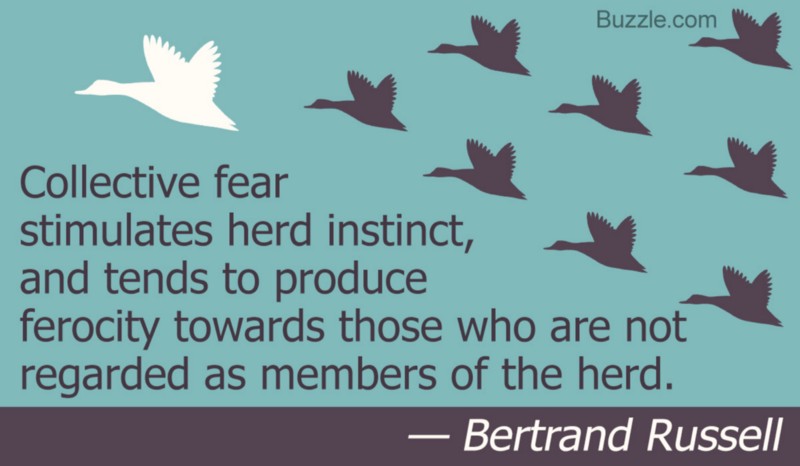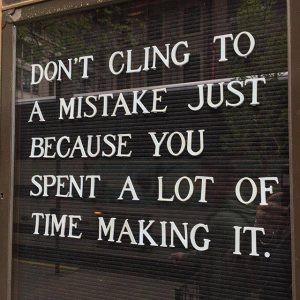Five decision making patterns that directly impact projects

Human psychology is built upon thought patterns acquired through conditioning and life experiences and it is through these patterns that people make decisions. These patterns are hardwired into our neurological network with different intensities that depend on the impact of the experience that produced the pattern. This article describes some common unhelpful pattern based fallacies that one gets trapped in at critical junctions of the project. Unsurprisingly, these mistakes compromise the strategy and result of the project.
The author of "The Art of Thinking Clearly" Rolf Dobelli discusses how people fail to think with clarity. He explains how the mind gradually shifts from clear and logical clear thinking to one that may be prone to errors.
The Herd Mentality
The best examples are the latest fashion trends and fads. For example, with the rising popularity of fidget spinners, everyone wanted one even if they had no idea what it was meant for. The Herd Instinct is also known as "social proof." It is a behavior whereby individuals feel that they are behaving correctly when they act the same as other people. Social proof is the evil behind housing bubbles and stock panic. It also exists in the building industry where the decision makers just follow someone or imitate something that has been done in a certain way, essentially copying the idea either wholly or partly.
Businesses that contemplate the undertaking of projects look towards the competition to see what they are doing in order to copy them. Ultimately, they repeat the actions of the competition only to commit the same blunders.

This may be seen in the housing sector where most apartments look alike. And another practice that has been repeatedly copied around the world is the use of tinted glass which is why half of the world's buildings look the same. Tinted windows can be a disadvantage in hotter climates because such buildings become hot in the summers (owing to the greenhouse effect by the tinted window). Many contractors simply use tinted glass in their buildings without considering the advantages and disadvantages.
Action Bias
Some students begin solving the math problem straight away without careful consideration. This might lead to a wrong result or it can get them stuck.
"Action Bias" simply means a tendency to act quickly without much careful planning. In project management such as building construction, this can happen quite easily. The planning phase in construction projects may be the most important. A well thought out plan may prevent many problems in the future. And a quick plan might fail to anticipate problems so problems may be created through rushed planning.

Some people think that planning is a waste of time. But a carefully drawn plan may protect against pitfalls and therefore can save time in the long run. Instead of wasting time, careful project planning can actually save time. A reasonable amount of time may be given to plan the process of delivering the project objectives within the given time frame.
Outcome Bias
A common example of this can be seen when a relative explains how their doctor successfully treated them. The rest of the family will now rush to see this doctor and expect the same quick results without considering the severity and specifics of their own health conditions.
This may happen quite often because some people may just think about the outcome without carefully thinking about the circumstances that produced the outcome. The emphasis is on the outcome. The factors that led to the outcome tend to be disregarded.
A person may learn that one of his colleagues earned a great return on a real estate investment. He disregards the fact that the successful investment was made possible at that time due to low interest rates and in the present the return won't be so high because of higher current interest rates.
Though this sounds like rational process, it may be incorrect because the outcome could have been purely circumstantial or random.
Alternative Blindness
This can be seen, for instance, when a driver approaches a junction leading to two directions. He will choose either one of these and may not realize that the correct turn was left behind. This method of thinking may narrow the thinker's vision and possibly block out rational possibilities.
A common fallacy might occur when it appears to the decision maker that there are only two options to choose from. So if option A is not right, then option B must surely be correct. The decision maker may fail to recognize that that there might be more than two options available.
Even for projects, many people commit this error which can spoil the project outcome. Without trying to find more possibilities, they choose only between the two options placed in front of them. They don't realize that there are other options that are more suitable.
The Fallacy of Sunken Costs
The following thought process may be commonly seen: "if we stop injecting money into this scheme, the previous investments will stand wasted." This mode of thinking may ignore the fact that the scheme may be futile. More often than not, investors might reach a point in the project where they find out that further investment is not worthwhile but quite simply continue to invest more because of the large amounts previously invested. However, the correct approach in such a situation is to stop further investments so that further losses are avoided.

A relevant example is the supersonic jetliner the Concorde. Though it's a beautiful invention, many don't know that at a stage in development period, the analysis projected that it would not to be a good investment. Yet investors continued to invest in it and engineers pressed forward with design since there were already half-way into the project. Though the objectives to carry the project became very different and lead to creation of perhaps one off the greatest engineering marvels till now, the example sits well for sunken cost fallacy. (Disclaimer: We are not accusing any one or any case. The example should be taken only in our context.)
Remarks
Without realizing it, many people may commit one or more of the previously mentioned errors. It is worthwhile to think consciously and deliberately to ourselves, questioning the rationality of every decision made and to think consciously as far as possible.
These were some factors that can impede successful project planning. A wise planning strategy that avoids these traps is the best way to proceed with the project.
By carefully considering the aforementioned fallacies concerning decision making, we can avoid many of the most common (and usually costly) mistakes that ensnare decision makers.

